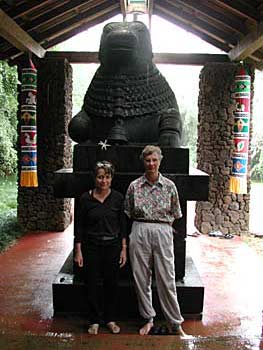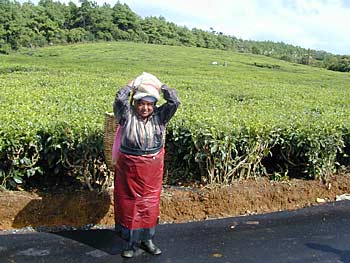Blog Archives
February 25, 2001 
Gurudeva is in wonderful spirits and working carefully with his monastics to finish up the "grand cleansing" of the performance of the "Maha Vasana Daha Tantra" (purification of mind by writing down all the experiences of your lifetime and burning them.) and begin an in-depth study of Shum, the language of meditation.
|
Title: Performance of Japa Yoga, Outcome of Pranayama |
Cybertalk: A cyberspace devotee from Singapore wants to know why we use the middle finger to move the beads when performing japa. Gurudeva says that we do not use the index finger because in would make this finger very strong and if it was ever pointed at someone then it might injure them in some psychic way. Another question is posed to Gurudeva from an e-devotee in India who asks if the performance of pranayama and yoga asanas can lead to samadhi. Gurudeva says that this harmonizes the masculine and feminine forces within and sets the foundation for meditation.
Cybertalk Ends"
For more information about listening to Gurudeva's talks online and to hear them in other formats, click here.
Gurudeva will be happy to hold "Prasnottara Satsang" -- "Questions and Answers" over the telephone with any Hindu religious societies, Hindu youth groups, Radio talk show hosts etc. All you need is a phone with a speaker and an enthusiastic audience. Arrangements may be made in advance by sending email to Sivadevanathaswami
Do you have questions for Gurudeva? Send to questions@hindu.org.
Please note: Gurudeva only responds to questions from the general public on matters that are suitable for our public cyber audience. Personal or intimate questions sent to this address are not answered.
A detailed index of past inspired talks is available here.
transcription begins
Transcription of One of Gurudeva's CyberTalks
Date: February_17_2001
Title: Arthur Pacheco interviews Gurudeva Part 5
Category: The Guru
Duration: 1 min., 49 seconds
Date Given: January 27, 2001
Arthur: One more question, if I might ask you? For someone who has just stumbled across meditation and feels the call to meditate, what would be some of the guidelines that you might suggest, in that you have had something to do with this science for so long?
Gurudeva: Well, we have been teaching meditation for over fifty years. The basis of meditation is quieting the mind through concentration. Those who work on the computer are potentially good meditators because they do have concentration. When you are working on a computer or surfing the web, you do not have body consciousness. You can close your eyes and you can go into meditation. Whatever you meditate on, is the state of consciousness that you are in at that particular time. So the idea is to meditate on higher things, rather than the lower things, of life. We are all meditating at one stage or another. It is the subject matter that needs to be changed.
Arthur: I see.
Gurudeva: Oh, before we close Arthur, I am going to give you and our radio audience, a magic mantra. Our radio audience, don't turn off the radio.
Arthur: Oh!
Gurudeva: A really wonderful mantra, before we conclude.
Arthur: Okay.
Gurudeva: It is the mantra that will heal interpersonal relationship and bring an end to conflict. This is a mantra that can be said in any language and it is only six words. It is easy to memorize. So don't turn that dial, just keep listening and we will finally get to it.
Arthur: Thank you very much.
Gurudeva: You remind me, Arthur, so I don't forget.
Arthur: I will, I definitely will. Thank you.
transcription ends

On the left is Shanti Devi, a college professor of Eastern religion and philosophy in Kona, Hawaii with her friend Barbara Summerhawk from Tokyo. Shanti Devi met Gurudeva 30 years ago in San Francisco and is a disciple of Swami Bramananda.
The large stone statue of the bull, is Nandi, Lord Siva's vahana or "vehicle." A representation of the perfect devotee, his right eye is focused on the right eye of Lord Siva Nataraja, the Lord of Dance in the temple.

We are blessed with fresh daily rains over the past week or two. All the plants are bursting with freshness and one has this sense of the Divine Fullness which is expressed in the Vedas as "Purna." There is a famous Sanskrit chant:
Om poornamada, poornamidam,
Poornaat, poornam udachyate,
Poornasya poornamadaya
Poornam evavashishiyate
That is Fullness, this is Fullness,
from Fullness comes Fullness.
When Fullness is taken from Fullness,
Fullness remains.

On the secluded and very peaceful path of the Saivite saints where pilgrims can wander through a tropical glen and ponder their spiritual evolution and be filled with the love of God in solitude... another Siva Lingam resides. Here you may fetch water from the stream and do your own bathing of the sacred image of the formless One. Recently a small Nandi has been installed here as well, the faithful one, lower mind subdued, fully God-centered in consciousness.

Thambynathan Nutanaya took the photo above, this one and the one below, as we are training him on how to use the camera. Our Sun One parade to San Marga.

The parade takes us on to the "pradakshina" or circumambulation of the Iraivan temple foundation. This practice is an important one in Hindu worship. One can "go 'round" your own Atma or soul in a microcosmic way, by simply turning around to the right. Upon approaching a temple from afar, especially for the first time on a long piligrimage, it is customary to walk all around the temple before entering, and then, even after entering, walk around the central sanctum, both before and after worship. This is a simple but powerful tantra... making God the axis of your consciousness. And for the fortunate and very brave, you might even go to Mount Kailas, Siva's abode high in the Himalayas and circumambulate the center of the universe: a 30-mile trek under severe conditions at high altitude... do this by prostrating the length of your body the entire way to cover the distance, and it is said all your sins will be forever transformed.
![]()
Gurudeva's other monastery in the island country of Mauritius
in the Indian Ocean near South Africa

Postcards from Mauritius: On the trade-wind facing slopes of the central highlands there are 1700 acres (688 hectares) planted in Assam tea. Coffee and tea plants (camelia sinensis) like hot days, cool nights, and plenty of rain. During the growing season, tea is harvested every seven days. Only the two tender uppermost leaves and terminal buds are plucked by hand.
Here's a Hindu lady who has obviously been working at the Bois Cheri estate for many years. She and her co-workers (some seen in the far background) harvested over 1.5 million kilos of tea last year. She was thrilled to receive some vibhuti from our photographer.

Green tea is known to possess many health benefits. Pictured here is the Bois Cheri estate's description of how they process it. Only a minute fraction of the harvest is sold as green tea. In fact, this is one of only two places in the world you can buy it: here or at a tea shop in Berlin! Most of the rest becomes Curl Twist and Cut (CTC) black tea flavored with vanilla.
